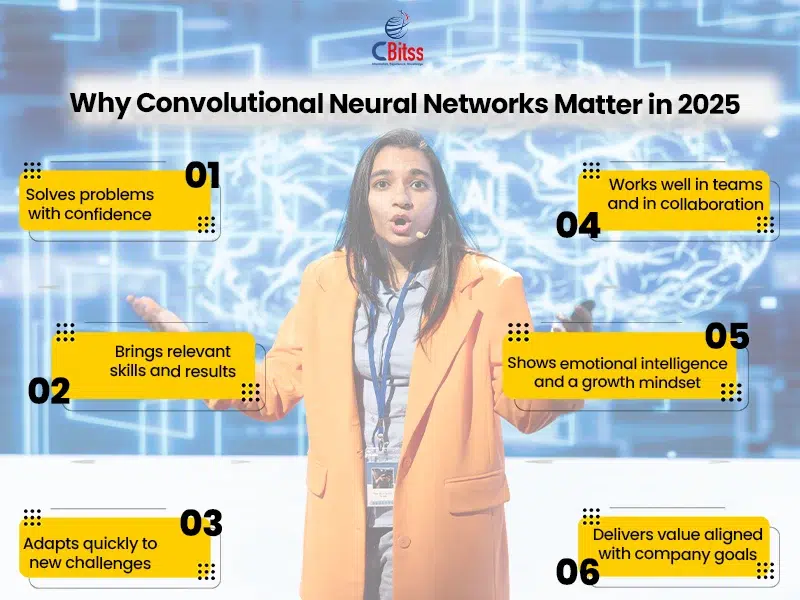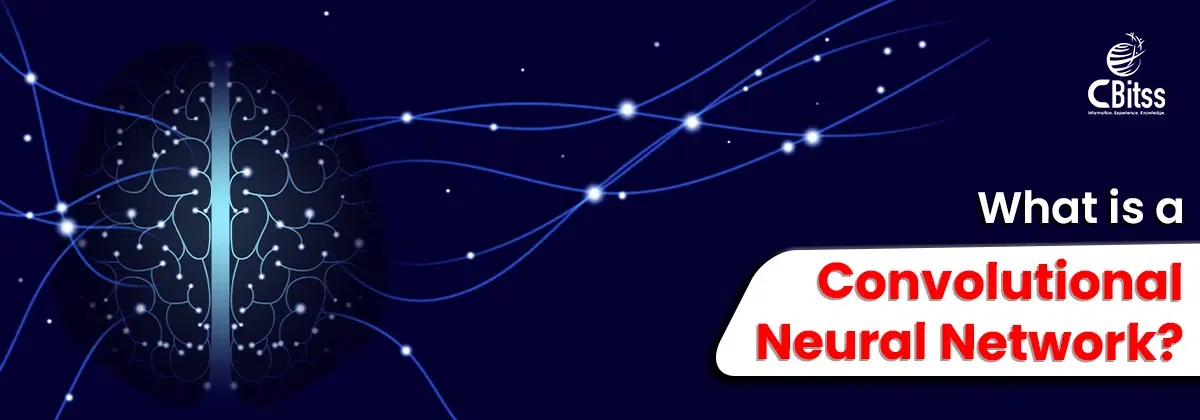Table of Contents
ToggleIntroduction
Have you ever asked yourself what is a Convolutional Neural Network and why it will drive innovation in 2025?
The term might sound complicated, unless you are already in the field of AI, but generally, its impact is ubiquitous, as it is used in stock markets and on smartphones. In this architecture, filters are applied to intercept hidden patterns, which are surely beyond the capability of human beings to detect subtle signals. Further, as opposed to the older models, it learns automatically, adapts to new inputs, and scales with huge data streams.
In this guide, you will discover what a Convolutional Neural Network is, its application in finance, the creative sector, and sustainability, and how organizations can implement it in their real-life practice. At the close, you would not only have a clue of CNNs but also why they have been very fundamental drivers of intelligence in the digital economy.
Core Elements That Shape CNNs
Several fundamental components undeniably form the intelligence of a convolutional neural network:
Feature Extraction: Filters truly point out edges, shapes, and textures.
Dimensional Reduction: Pooling techniques are condensing techniques.
Nonlinear Mapping: Functions are used to characterize the complexity of the real world.
Integration: In layers, combine features into features.
Prediction: Final outputs provide classification or forecasting.
These components clarify what a Convolutional Neural Network is: not only a technical architecture but a potent machine that turns an unstructured feed as input and generates accurate results as output. Learn how designers use these patterns in advanced graphic design classes in Chandigarh to create futuristic visuals.

Fields Where CNNs Lead in 2025 and Beyond
- Convolutional neural networks are applied in medicine to identify latent conditions.
- CNNs are used in climate science to analyse satellite images.
- Convolutional neural network stock market models are used in finance to identify volatility.
- Fraud prevention uses CNNs on transactions.
- The logo of CNN has found its way into innovative ideas in creative industries.
These different applications demonstrate that CNNs can go far beyond image classification applications in the process of decision-making systems within industries.
CNNs as Cultural and Branding Icons
The convolutional neural network logo has become a cultural icon of flexibility and smartness. CNN-inspired visuals are part of the brand, which means trust and transparency. CNNs are used by designers to create adaptive logos that change the style with context. Activation visualizations can also be used as artistic devices, and heat maps are even used as artistic ones, to give audiences a glimpse into what machine reasoning is doing.
Marketers seeking growth should also study achieving first page ranking on Google to see how AI-powered analytics enhance visibility.
Acquire in-demand CNN expertise with structured and interactive sessions
Barriers That Demand Innovation
CNNs have disadvantages that require radical solutions despite their advantages:
- During the training of deep architectures, the cost of energy increases.
- CNNs require large and varied datasets to be accurate.
- Adversarial attacks have vulnerabilities.
- The hurdle of integration is evident in the older systems of IT.
- The artificial intelligence skills are limited in most groups.
These obstacles demonstrate the reason why the implementation of a CNN would not only need technology but also strategy and human resource advancement.
Evolving Horizons of CNNs
The future of convolutional neural networks will be towards flexibility. Scientists are working on self-adaptive filters and multimodal systems that combine vision, text, and sound. Sharper convolutional neural network stock market systems, in finance, predict changes in seconds. When it comes to branding, the convolutional neural network logo would serve to remind people of the transparency created by AI.
It is no longer about the question of what is a Convolutional Neural Network, but rather how far CNNs can take industries. Learn how developers present such breakthroughs in a web designer vs web developer discussion to bridge design and coding.
CNNs in Edge and Mobile Devices
Edge and mobile platforms are now CNNs-powered platforms that bring intelligence closer to the users:
- Smartphones also have CNNs to recognize faces and have real-time filters.
- IoT devices use CNNs in the case of predictive maintenance.
- AR and VR are based on CNNs to track objects in an immersive manner.
- Wearables execute CNNs for in vivo health monitoring.
Convolution neural network models provide low latency, private, and low-energy intelligence at the edge by reducing the use of cloud servers. Businesses exploring AI deployment can also learn why keyword research is important to capture user intent in CNN-driven apps.
Ethical Dimensions of CNN Adoption
Ethics is a significant factor in the popularity of CNNs. Fairness, transparency, and accountability must be maintained in companies. CNNs may be biased to the dataset without the researcher’s intention, which will result in unfair outcomes. Companies are currently constructing understandable CNNs that reveal decision-making. This transparency is reassuring to the users in sensitive fields such as healthcare and finance.
The moral use of a network of convolutional neural makes them black-box systems rather than systems of trust. These lessons align with top data science trends where fairness and transparency are key.
Practical CNN lessons designed for learners seeking real-world applications
CNNs and Human Creativity
CNNs give power to creativity as never before. They are used by artists to create generative paintings, but designers use them to create adaptive branding. The logo is associated with trust and futuristic design in the field of advertising. CNNs are used to remix sounds by musicians and visuals to improve narratives by storytellers.
CNNs transform creativity itself by providing the combination of algorithmic accuracy and creativity. For those interested in content careers, here are the top content writing institutes where AI creativity is now part of training
CNNs in Personalized Experiences
- Streaming services use CNNs in order to provide real-time suggestions.
- E-learning alters the study paths based on CNN-powered insights.
- The product suggestions are done by retail platforms using visual CNN recognition.
- The health apps use CNNs to receive personal fitness and diet recommendations.
- Games combine CNNs to adapt to the dynamic play.
These illustrations underscore what is a Convolutional Neural Network besides analytics, a driver of personalized experiences, which is responsive to the needs of an individual. Writers can learn fresh tips from this web story on content writing to craft engaging CNN-powered experiences.
CNNs in Security and Defense
Security and defense industries cannot do without them:
- Surveillance systems are used to analyze live footage in terms of threats.
- Cybersecurity platforms with CNNs are used to identify abnormal traffic.
- Military use is the autonomous navigation of CNNs.
- CNNs are used in border surveillance.
These applications demonstrate that a convolutional neural network is not only a tool used to work with data but also a security barrier.
CNNs and Sustainability
- Smart energy grids are based on CNN forecasting to balance resources.
- Precision farming uses CNNs to optimize the process of irrigation.
- The CNNs are relied on by climate research to monitor pollution.
- Waste systems use CNNs to sort materials accurately.
- Water networks save water through CNNs to identify leaks and conserve water.
Covering the environmental issues, convolutional neural networks convert sustainability into a practical step, and even impact the stock market of CNN through the lens of ESG-oriented analytics.
CNNs Beyond 2030: A Vision
CNNs can also be combined with neuromorphic chips to make them more like the human brain by 2030. Adaptive CNNs will upgrade themselves where they need very little retraining. Finance Advanced convolutional neural network stock market systems will deal with predictions of the stock market at microsecond levels. The logo will further be adopted as a symbol of creativity among creative industries. Eventually, CNNs can develop into self-directed engines of society.

Conclusion
Now, you have an idea of what is a Convolutional Neural Network, the way it works, and why it cannot be replaced in 2025 and even later.
CNNs transform industries, from sustainability to branding. Organizations can have foresight and a competitive advantage by incorporating the convolutional neural network logo in branding and CNN stock market models in the financial sector. What is even more powerful about CNNs is their ability to be precise, as well as flexible in various disciplines.
Technology is advancing rapidly, and early adoption would be beneficial to the leaders.
To begin, learn how convolution neural network in the present time creates prototypes, test models, and experiments with us.
Will you be able to make the future with CNNs?
It is time to start the journey and unleash the transformative power of a network of convolutional neural.

Sukhamrit Kaur
Sukhamrit Kaur is an SEO writer who loves simplifying complex topics. She has helped companies like Data World, DataCamp, and Rask AI create engaging and informative content for their audiences. You can connect with her on LinkedIn.







